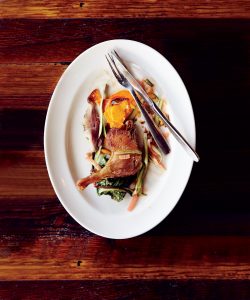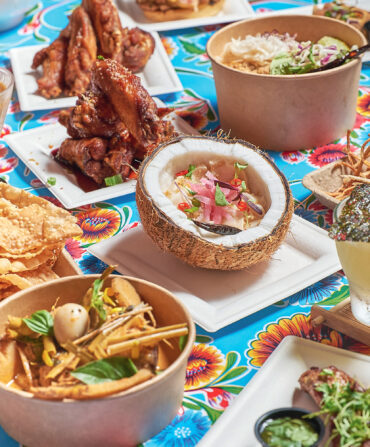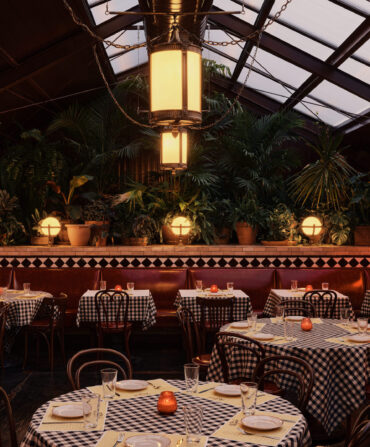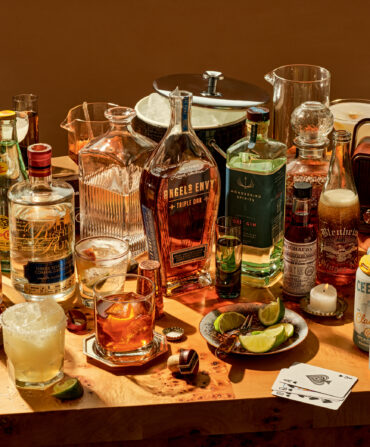Food & Drink
The Second Coming of John Fleer
After leaving his post at Blackberry Farm, the chef is back with two Blue Ridge restaurants and visions of a new kind of Foothills Cuisine
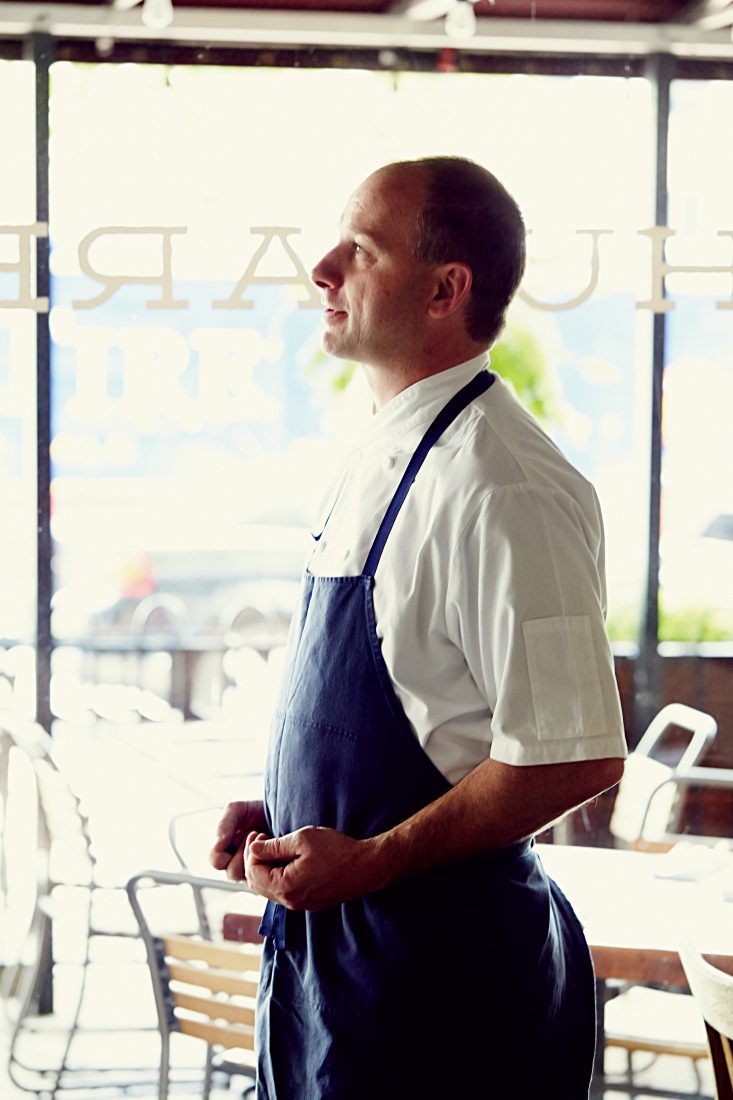
Photo: William Hereford
John Fleer is having second thoughts about Merkel Pie.
Of the prized spongiform fungi better known outside the Smoky Mountain foothills as morels, Fleer observes: “One of the great cultural things I picked up in East Tennessee”—not a phrase one hears every day—“was a traditional recipe for a shepherd’s pie made with morels, which they call merkels, and bacon and mashed potatoes.”
The pie is “authentically hillbilly,” Fleer says, approvingly. And it had served him well at Blackberry Farm, where it was typical of the kind of overlooked, humble Southern fare he unearthed, elevated, and celebrated during his nearly fifteen-year run at the Relais & Châteaux resort in Walland, Tennessee.
But Fleer’s restaurant Rhubarb, which he opened in Asheville, North Carolina, last October, isn’t bucolic Blackberry. And he isn’t sure such an explicit throwback of a dish, even one as pleasing to eat and say as Merkel Pie, fits with the mission and spirit of the new place.
The restaurant occupies a series of linked Pack Square storefronts at the center of town that have lived a variety of lives. “This room was a porn bookstore,” Fleer says, grinning. Swan-neck steel lamps now protrude from peeling walls preserved in a state of sweet decay. Wood tables are quartersawn and rough-hewn, the exposed ducting above painted gray black in keeping with current vogue for the urban-woodsy-industrial style.
In the relative calm before service, cooks in the back stoke the fire in an open grill and feed split logs into a pair of hungry wood ovens. Near the entrance, some ukulele buskers are playing for change and tourists are taking a breather on benches. Across the street, the towering stone monument to nineteenth-century governor Zebulon Baird Vance stands alone in the empty plaza like a rocket on its launchpad. And there by the door, John Fleer, arguably the most influential yet wildly undercelebrated Southern chef of his generation, is fretting over the wording on tonight’s menu.
“I’m prone to giving credit to every single producer,” Fleer says. “But I’m on a kick now to simplify the
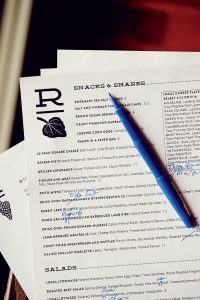
Photo: William Hereford
Handwritten notes on a menu in progress.
language. Because I’ve watched people get freaked out by the menu and walk away.”
Mostly, though, they’ve been walking toward. Packing these stylishly repurposed rooms every night. Pulled in by the promise of those words on the menu: buttermilk fried soft-shell crabs with spring pea rémoulade; rabbit and leek rillettes with apple mostarda; sweetbreads and buckwheat waffles with porcini honey. And drawn, too, by the chance to learn what Fleer has up his sleeve seven years after he left Blackberry to spend more time with his wife and three boys, coach his son’s soccer team, and recharge his batteries. To see what the man who founded a movement rooted in the rural specifics of place and tradition might do with a very different kind of restaurant, one that’s off the farm, in town, and all his own.
Chief among those eager to check in are his esteemed colleagues from the fraternity of well-known Southern chefs.
“I’m telling you, man, he’s the most unsung hero in Southern food,” says Sean Brock in purred admiration. Brock credits Fleer with changing his life with a chilled soup of cornbread and buttermilk. “He started all this, he really did.”
Hugh Acheson calls him a “Jedi Master” and “the quiet godfather of a movement in the mountains who put Blackberry on the map.”
John Currence remembers hearing the first rumblings of a new kind of Foothills Cuisine and thinking, “Okay, really? Eastern Tennessee—how interesting can this be? Then I finally went and saw how hard he was digging into the local artisans and farmers. And I ate his food and was ashamed to call myself a chef. It was truly that astounding.”
“Never in my wildest dreams did I think I’d end up in Tennessee,” Fleer says with a smile.
We’re in his car driving fast from Asheville up around the shady granite canyons of the Blue Ridge Mountains. In addition to his restaurant in the city, Fleer runs Canyon Kitchen, a big luxury barn of a destination restaurant at Lonesome Valley, a gated community nestled between stone cliffs and founded by the family of his friend (and longtime trout supplier) Sally Jennings Eason. After Fleer left Blackberry, Eason and her brother Dickie Jennings asked Fleer to do something with the space originally intended as a sports barn and recreation facility for club members
“There’s a lot of money up here,” Fleer says. “A lot of places with a country club feel. Lonesome Valley was started to be something different. And it’s all about the hiking and open space. They don’t have a golf course; they have Frisbee golf.”
Cooking up here seemed like an ideal way to balance the rest he needed with keeping his hand in the kitchen. These days, he’s got his hands full at Rhubarb but he’s still very involved with operations at Canyon Kitchen and drives between the restaurants regularly. That’s partially because he’s not one to shy away from extra work, but also he simply loves the quiet here. “Truly it’s one of the most beautiful places on earth,” he says.
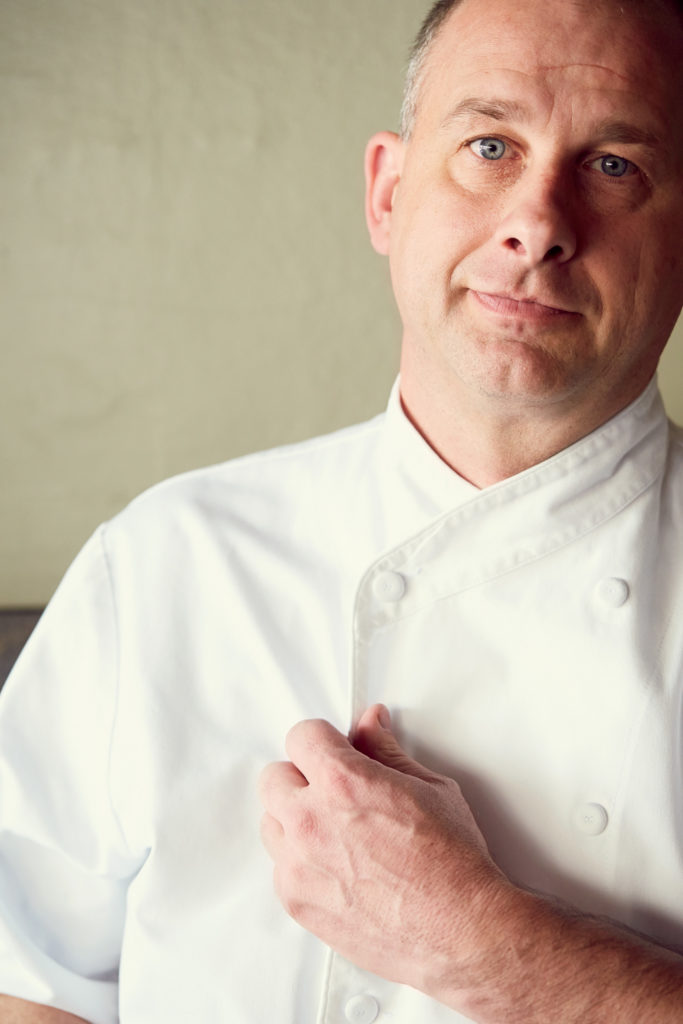
Photo: William Hereford
Starting Fresh
The chef in his whites.
Fleer’s a modest guy. Twinkly gray-blue eyes set under arched eyebrows, a big grin that tends to creep up one side of his face before breaking into an easy giggle.
He grew up in Winston-Salem, North Carolina. His dad taught political science at Wake Forest (“Flunkin’ Fleer,” they called him; indeed, legend has it he once flunked John Currence’s brother).
Fleer claims no early transcendent connection to the food of the South, no precocious enlightenment moment in the kitchen. “I grew up on casseroles plus a few dishes that my mom inherited from her family: Brunswick stew, stewed corn and tomatoes.” Summers were spent with grandparents in Tidewater Virginia who liked to cook. “Those were formative memories, but I wasn’t engaged except to eat.”
A study-abroad season in Venice got him in the habit of shopping the fruttivendolo and food markets and cooking for a group of housemates. After graduating from Duke with a major in theology, he went to graduate school at the University of North Carolina at Chapel Hill to study religion and philosophy. He took a three-day-a-week job at a restaurant called Aurora “to pay the bills.” But after a few months rolling pasta and working pastry, he realized his calling was in the kitchen and not the library.
He dropped out and enrolled at the Culinary Institute of America in Hyde Park, New York. After graduation he stayed on for a spell at one of the school’s restaurants and had a weekend gig as private chef for Mary Tyler Moore.
Fleer had married his high school sweetheart, Katy, now a clinical psychologist. Both were eager to return to the South. When Blackberry came calling, Fleer was excited but unsure what he’d signed on for.
“There was a time in my first six months that I thought I would not last,” he says. There was the adjustment to living in an insular and unfamiliar community, the remoteness of the place, and the challenge of building something new and worthwhile there. “The greatest thing that ever happened there was when [Blackberry co-owner] Kreis Beall said, ‘I want you to go write your culinary vision for this place.’”
Committing himself to a new vision and task, Fleer produced a 1,300-word, three-page, single-spaced typewritten manifesto. “I wrote about food that had heart and history, about heirloom vegetables and the importance of growing a garden and producing what we were serving,” he says. “I had absolutely no business writing any of this! But it set us on a track and gave us our marching orders.”
A decade before René Redzepi and friends presented “Manifesto for the New Nordic Kitchen,” proclaiming a New Nordic cuisine based on local traditions and ingredients, Fleer wrote his brief for the establishment of Foothills Cuisine and how a little hotel restaurant might honor the producers and techniques native to the region around Walland.
But first he had to locate farmers and dig up old recipes. “Country ham is a critical part of the cuisine of the South, so the thinking was, let’s just go out and find the best producer.” That led to Allan Benton—who was at the time selling his fine hams to roadside farm stands and breakfast joints in Gatlinburg—which led to Benton’s being a certified ham rock star among chefs. (David Chang devotes a whole chapter to him in his Momofuku cookbook.) All of which led to a renaissance in Southern ham appreciation that led, in turn, to Benton’s producing a cured prosciutto-style ham, slices of which I would enjoy these many years later on an exceptional Monte Cristo sandwich at Rhubarb layered against Ashe County Gouda and Chop Shop bologna, all liberally slicked with sorghum-maple syrup. (Damn, that was a good sandwich.)
“I think of Fleer as a kind of curator of lost Southern goods and shepherd of young Southern chefs,” says the writer and Southern Food-ways Alliance director John T. Edge. “From Allan Benton to Earl and Cheri Cruze of Cruze Farm to Sean Brock and [Fleer’s old deputy and current Blackberry chef and recent James Beard Award winner] Joseph Lenn, he’s done really well.”
By way of context, Brock points out that while Fleer was establishing his reputation for ingenious sourcing in the early nineties, “people in Charleston were cooking Lowcountry cuisine with terrible products.”
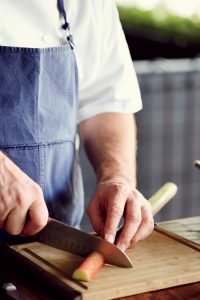
Photo: William Hereford
Fleer slicing rhubarb.
In his forthcoming cookbook, Heritage, Brock includes a recipe for cornbread and buttermilk soup, credited to Fleer and in memory of that transformative first meal at Blackberry. “Growing up, you crumble day-old cornbread in a coffee cup and pour buttermilk over it; I call it ‘redneck cereal,’” Brock says. “He took that and made it elegant. He didn’t turn it into a bubble floating above the table, but he took something very hillbilly and made it into a beautiful, elegant, silky soup and took my brain immediately back to my grandma’s kitchen. He gave me a sense of pride I’d never experienced in my life. I was eating off beautiful china and it was paired with unbelievable wines and I was like, this guy is brilliant.”
Fleer sent me a copy of the old Blackberry manifesto. In it he states: “I was born and raised in the South and it is Southern food that lies at the heart of my cooking.” But he adds too that the term Foothills Cuisine embraces the influence of far-flung yet complementary cultures. Sounding a bit like the still-recovering academic he was, he writes:
I would cite most specifically the Gascony region of France, the Basque Country of Spain, and food from the Veneto and Northern Italy. These regions share not only a terrain with us but a way of life based on small farms, lack of urban concentrations (and distractions), and most important, an intangible spirit of self-sufficiency unmatched by other cultures…. I hope that we can also bring flashes of the original to our guests, exposing them to foods and techniques from kindred foothills spirits….
It’s entirely possible and utterly sane to simply enjoy Rhubarb for the curated collection of really delicious things on offer: the Scene of the Crime, a tart fizzy dream of a cocktail made of barrel-aged North Carolina gin, Cynar, and beet-ginger shrub; thin slices of warm porchetta di testa (pig’s head), a louche hit of fat nicely enveloping the spring freshness of crisp green peas and fava and scarlet runner beans; the Rappahannock Oysters Benton with country ham and crumbly cornbread.
But it’s also interesting to read the menu as an expression of John Fleer’s progress, from progenitor of a new wave of vigorously sourced Southern food to a more personal style unmitigated by ideas of authenticity or pastoral purity. Here, in this bustling restaurant at the heart of a busy intersection in an artsy, interesting town, are North African influences and Mongolian spiced lamb ribs and ramps in a paper bag and doughnuts for breakfast.
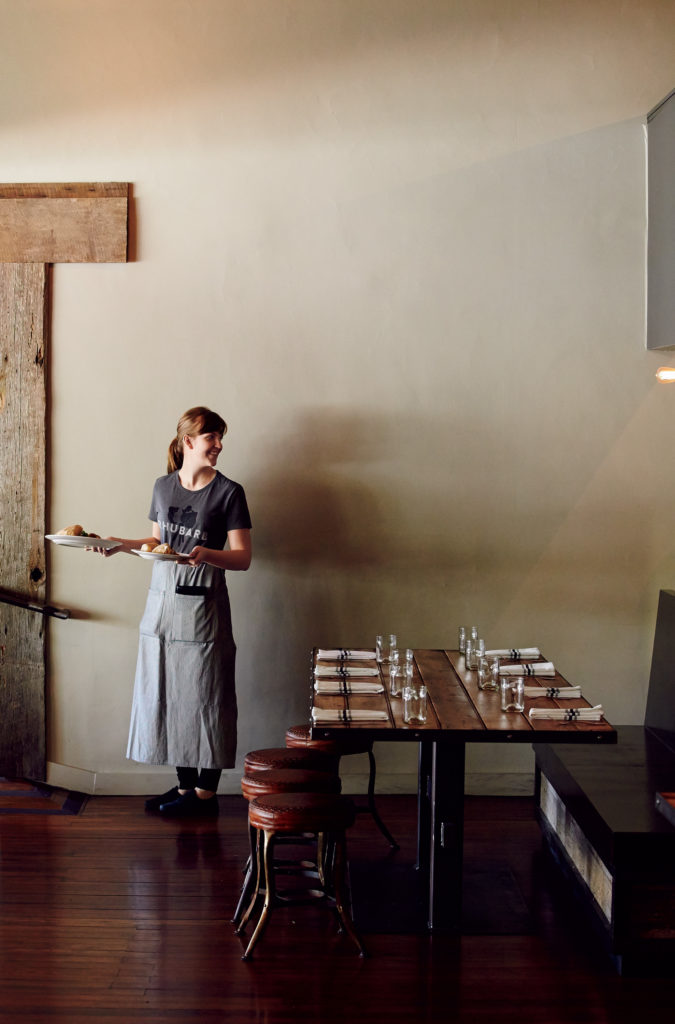
Photo: William Hereford
Service and a Smile
Erin Kaeding next to one of Rhubarb’s communal tables.
I ask Fleer if he is attempting to break free a bit from the constraints, imposed or imaginary, of his role as Jedi/godfather of revitalized hyper-local Southern cuisine.
“The conscious thing I’m doing here is trying to work around the definition that’s attached to me as a Southern chef,” he says, choosing the words carefully. “I feel like I did an honest day’s work carrying the flag, and that’ll always be part of me. What I did at Blackberry was to bring light to an old, traditional style of cooking and to recipes and ingredients. Now I’m very aware of not preserving that in amber and overromanticizing it.”
Fleer’s friend John Currence notes that a certain loosening of the strictures of tradition is one inescapable outcome of the success of pioneers like Fleer, Frank Stitt, Linton Hopkins, and others. “I think it’s a bit of an inevitability,” Currence says. “The food of the South is a result of dozens of different immigrant populations that were injected into this part of the country.”
At Rhubarb, the borders are “fuzzier” than they were at Blackberry, Fleer says.
So, has everything been found and preserved? Have all the old traditions and rare seed strains and once-forgotten dishes been brought into the light?
Fleer isn’t buying that. “I think it’s never ending,” he says of the evolution of Southern food. “There’s a lot less looking backward now than there was. I’m trying to build my foundation on great product. That’s the foremost thing I think about every day. It’s a different kind of pressure because I’m still figuring it all out.”
Looking over the menu, Fleer picks out the rabbit-leek rillettes as the kind of thing he’d like to see at a restaurant. “That’s what I’d want to eat on the porch with a glass of wine,” he says. “Last fall I tried incorporating a ton of leeks and mirepoix with the meat and just fell in love with the idea. It’s a more aromatic rillette and not just full-on meat. We do it with smoked trout bellies and lamb bellies and whatever we have a lot of.”
Fleer is still a perfectionist—the execution at Rhubarb is flawless—but the influences feel loose and improvisational, the creative energy palpably flowing.
“We’re still developing the food vernacular at Rhubarb,” he tells me later that night after dinner. “We’re still trying to figure out what kind of language we’re speaking here. But the idea behind it is liberating.”


